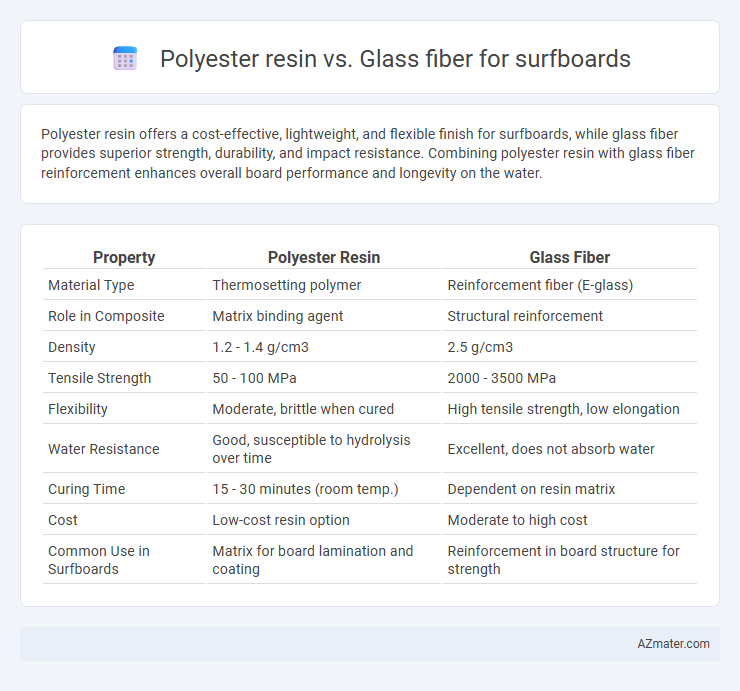Polyester resin offers a cost-effective, lightweight, and flexible finish for surfboards, while glass fiber provides superior strength, durability, and impact resistance. Combining polyester resin with glass fiber reinforcement enhances overall board performance and longevity on the water.
Table of Comparison
| Property | Polyester Resin | Glass Fiber |
|---|---|---|
| Material Type | Thermosetting polymer | Reinforcement fiber (E-glass) |
| Role in Composite | Matrix binding agent | Structural reinforcement |
| Density | 1.2 - 1.4 g/cm3 | 2.5 g/cm3 |
| Tensile Strength | 50 - 100 MPa | 2000 - 3500 MPa |
| Flexibility | Moderate, brittle when cured | High tensile strength, low elongation |
| Water Resistance | Good, susceptible to hydrolysis over time | Excellent, does not absorb water |
| Curing Time | 15 - 30 minutes (room temp.) | Dependent on resin matrix |
| Cost | Low-cost resin option | Moderate to high cost |
| Common Use in Surfboards | Matrix for board lamination and coating | Reinforcement in board structure for strength |
Introduction to Surfboard Materials
Polyester resin and glass fiber are primary materials in surfboard construction, offering distinct properties that influence performance and durability. Polyester resin, known for its affordability and ease of use, provides a rigid and lightweight finish, while glass fiber enhances strength and flexibility through layered reinforcement. Combining these materials optimizes surfboard resilience, impact resistance, and water resistance essential for high-quality surfboard manufacturing.
Understanding Polyester Resin
Polyester resin is a widely used material in surfboard manufacturing due to its affordability, easy curing process, and strong adhesion to glass fiber cloth, which reinforces the board's structure. It offers good mechanical strength and durability but tends to be more brittle and less UV-resistant compared to alternative resins like epoxy. Understanding polyester resin's chemical properties, such as its styrene monomer content and exothermic curing reaction, is crucial for optimizing fabrication techniques and producing high-performance glass fiber-reinforced surfboards.
What is Glass Fiber?
Glass fiber, a lightweight and high-strength material made from fine strands of glass woven into fabric, is widely used in surfboard construction for its excellent durability and flexibility. Unlike polyester resin alone, glass fiber provides enhanced structural integrity and resistance to impact and water damage, making surfboards more robust and long-lasting. Its compatibility with polyester resin allows for a strong composite that balances stiffness and responsiveness essential for high-performance surfing.
Strength and Durability Comparison
Polyester resin, commonly used in surfboard construction, offers good adhesion and ease of use but has lower impact resistance compared to glass fiber reinforcement. Glass fiber significantly enhances the strength and durability of surfboards by providing superior tensile strength and resistance to flexing and cracking under stress. The combination of polyester resin with glass fiber results in a surfboard that balances lightweight performance with high durability and structural integrity in challenging surf conditions.
Weight Differences Between Materials
Polyester resin is significantly lighter than glass fiber, contributing to a reduced overall surfboard weight. Glass fiber adds structural strength but increases the board's weight, often resulting in a heavier and less maneuverable surfboard compared to those made primarily with polyester resin. Choosing between these materials impacts the balance between durability and portability based on the desired weight characteristics.
Flexibility and Performance Impacts
Polyester resin offers greater rigidity but less flexibility compared to glass fiber, leading to a stiffer surfboard that can reduce overall maneuverability. Glass fiber enhances flexibility and impact resistance, allowing for better energy absorption and improved board responsiveness during dynamic movements. This combination of materials directly influences surfboard performance, with glass fiber-reinforced boards typically providing a smoother ride and enhanced durability.
Cost Considerations for Surfboard Construction
Polyester resin is generally more cost-effective than glass fiber for surfboard construction, as it is cheaper to produce and widely available, lowering overall material expenses. Glass fiber adds strength and durability but increases costs due to higher-priced fibers and additional labor involved in handling and layering. Budget-conscious surfers often choose polyester resin with standard glass fiber reinforcement to balance performance with affordability in surfboard manufacturing.
Repair and Maintenance Challenges
Polyester resin offers easier repairability and faster curing times, but it tends to be more brittle and prone to cracking under stress compared to glass fiber. Glass fiber reinforcement provides greater structural strength and durability, yet its repair process requires specialized materials and techniques, often involving epoxy resins, which can complicate maintenance. Regular inspection is crucial for both materials to detect micro-fractures or delamination early, ensuring longevity and optimal performance of the surfboard.
Environmental Sustainability of Both Materials
Polyester resin, commonly used in surfboards, emits volatile organic compounds (VOCs) during curing, contributing to air pollution and health hazards, while glass fiber reinforcement, derived from silica, is energy-intensive to produce and non-biodegradable, posing disposal challenges. Alternatives like bio-based resins and recycled glass fibers are emerging to enhance environmental sustainability by reducing carbon footprints and improving recyclability. The ecological impact of both materials necessitates advancements in eco-friendly formulations and sustainable manufacturing processes within the surfboard industry.
Choosing the Right Material for Your Surfboard
Polyester resin offers affordability and ease of use, making it a popular choice for surfboard construction, but it tends to be less durable and more prone to yellowing over time compared to epoxy resin. Glass fiber, often used in combination with polyester resin, provides essential structural strength and impact resistance, enhancing the surfboard's longevity and performance in various wave conditions. Selecting the right material depends on balancing cost, weight, durability, and repairability, with polyester and glass fiber being suitable for budget-conscious surfers seeking reliable performance without compromising board integrity.

Infographic: Polyester resin vs Glass fiber for Surfboard
 azmater.com
azmater.com